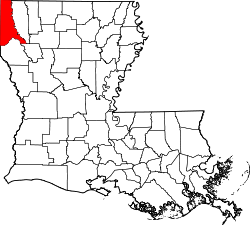Kansas City Southern Railroad Bridge, Cross Bayou | |
|---|---|
 Looking east from North Spring Street road bridge. | |
| Coordinates | 32°31′08″N93°45′00″W / 32.519°N 93.75°W |
| Carries | Railroad (defunct) |
| Crosses | Cross Bayou |
| Locale | Shreveport, LA |
| Owner | City of Shreveport |
| Characteristics | |
| Design | Truss |
| Material | Steel |
| Total length | 354 ft (107.9 m) |
| Width | 14 ft (4.3 m) |
| Height | 40 ft (12 m) (central A-frame) |
| No. of spans | 3 |
| Piers in water | 2 |
| History | |
| Designer | J.A.L. Waddell, Consulting Engineer |
| Opened | 1926 1890s (original location) |
Kansas City Southern Railroad Bridge, Cross Bayou | |
| Location | Over Cross Bayou, between North Spring Street bridge and Clyde Fant Memorial Parkway bridge, Shreveport, Louisiana |
| Built | Mid-1890s |
| Architectural style | Waddell "A" Truss Bridge |
| NRHP reference No. | 90002173 |
| Added to NRHP | March 23, 1995 |
| Location | |
 | |
The Kansas City Southern Railroad Bridge (Cross Bayou), in downtown Shreveport, Louisiana, is an "A" Truss bridge erected in its current location in 1926 and abandoned in the 1980s. Due to its national significance to the progress of American bridge design, and its rarity as one of only two known surviving examples, the structure was designated a National Historic Place in 1995.


